前言:
redis6出来有段时间了,这个版本有不少的亮点,比如client cache、acl、resp3、io多线程等。对于redis6的新功能代码看的差不多了,复杂点主要集中在cache track和io thread上,个人对io多线程的设计和性能表现有些不认同。😅
压测数据本应该使用图表展现,奈何太懒.
io多线程是怎么一回事?
redis本身是有多个线程的,但worker线程只有一个,其他线程属于辅助线程,比如aof日志和bio线程。单个worker线程限制了redis的qps只有十几万,这里不算pipeline批量管道。redis是纯内存操作,对于磁盘的操作都是异步的,为什么只有十几万QPS? 单线程的worker只能跑在一个cpu core核心上,该线程不仅要处理epoll,要解包,要处理内存数据,要封包,要读写socket等等。通过火焰图得知最大的性能点在于socket write系统调用上。
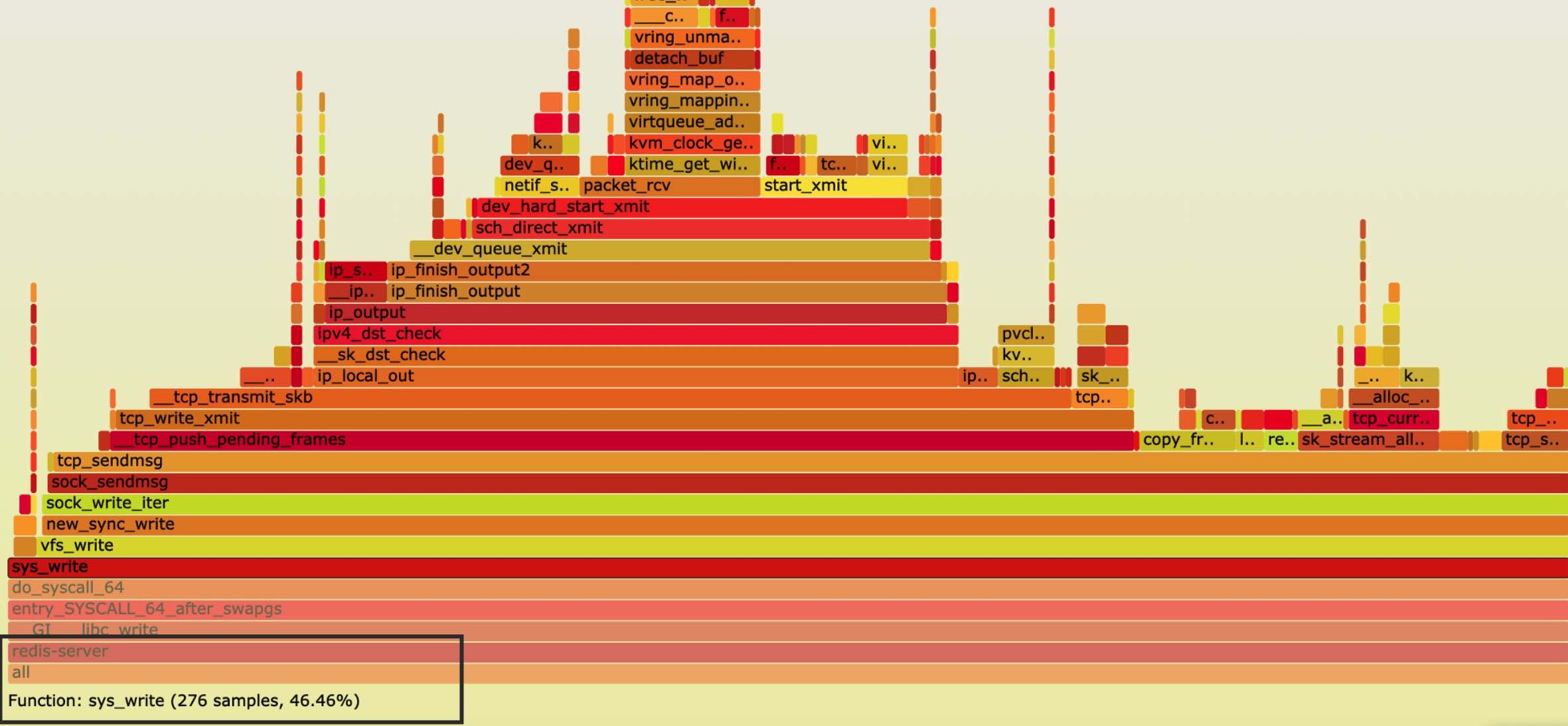
为了解决单线程的性能瓶颈,redis6给出了io多线程方案,处理数据的线程还是唯一,但处理读写socket和解析协议由多个io线程解决。
那么为什么不直接开多个wokrer线程? 规避锁竞争 ! 锁竞争会引起什么? 要么忙竞争,要么上下文切换。像其他kv服务器可通过虚拟db或者分段锁来减少竞争,但这个实现会对redis主体代码改动太大。
主流程
具体的代码实现我就不贴代码了,避免大家看着烦心。这里简单描述下他的实现,核心就是各种的轮询。
首先redis在启动时根据配置来实例化几个io线程。这里有几个变量要描述下,io_threads_active表示为当前io thead的激活状态,io_threads_list是一个存有任务list的数组,io_threads存有线程结构, io_threads_pending表明io thread是否有任务, io_threads_mutex存有每个io thread对应的锁,用来休眠和唤醒的。
// xiaorui.cc
void initThreadedIO(void) {
io_threads_active = 0; // 默认不激活io线程的工作状态
// 如果io thread为1,那么无意义,索性直接使用主线程处理,所以return
if (server.io_threads_num == 1) return;
// 不能超过128个io线程
if (server.io_threads_num > IO_THREADS_MAX_NUM) {
serverLog(LL_WARNING,"Fatal: too many I/O threads configured. "
"The maximum number is %d.", IO_THREADS_MAX_NUM);
exit(1);
}
for (int i = 0; i < server.io_threads_num; i++) {
io_threads_list[i] = listCreate(); // 任务列表
if (i == 0) continue; /* Thread 0 is the main thread. */
pthread_t tid;
pthread_mutex_init(&io_threads_mutex[i],NULL);
// 默认io线程对应的任务为0,标识无io任务
io_threads_pending[i] = 0;
// 默认锁定io线程对应的锁上
pthread_mutex_lock(&io_threads_mutex[i]);
// 创建线程,并启动iothreadmain方法。
if (pthread_create(&tid,NULL,IOThreadMain,(void*)(long)i) != 0) {
serverLog(LL_WARNING,"Fatal: Can't initialize IO thread.");
exit(1);
}
io_threads[i] = tid;
}
}主线程监听ae_epoll并拿到有事件的客户端,然后轮询分配给各个io线程绑定的io_threads_list链表里,把每个线程的io_threads_pending配置为当前io线程所分配的事件数,其他就是空轮询等待结果了,并收尾工作。
// xiaorui.cc
int handleClientsWithPendingWritesUsingThreads(void) {
// 1. 判断是否还有client对象需要写数据给客户端
int processed = listLength(server.clients_pending_write);
if (processed == 0) return 0; /* Return ASAP if there are no clients. */
// 2. 当io thread为1, 或者任务量少于(线程 * 2),则不使用多线程直接处理。
if (server.io_threads_num == 1 || stopThreadedIOIfNeeded()) {
return handleClientsWithPendingWrites();
}
/* Start threads if needed. */
// 3. 如果未开启io多线程,则开启,所谓的开启就是唤醒线程对应的锁。
if (!io_threads_active) startThreadedIO();
if (tio_debug) printf("%d TOTAL WRITE pending clients\n", processed);
/* Distribute the clients across N different lists. */
listIter li;
listNode *ln;
listRewind(server.clients_pending_write,&li);
int item_id = 0;
// 4.按照RoundRobin算法把需要返回数据的client对象分配给IO线程,简单而高效。
while((ln = listNext(&li))) {
client *c = listNodeValue(ln);
c->flags &= ~CLIENT_PENDING_WRITE;
int target_id = item_id % server.io_threads_num;
listAddNodeTail(io_threads_list[target_id],c);
item_id++;
}
/* Give the start condition to the waiting threads, by setting the
* start condition atomic var. */
// 5. 设置标志位为写操作,统计各个io线程需要处理的client的个数
io_threads_op = IO_THREADS_OP_WRITE;
for (int j = 0; j < server.io_threads_num; j++) {
int count = listLength(io_threads_list[j]);
io_threads_pending[j] = count;
}
/* Wait for all threads to end their work. */
// 6. 空循环等待所有的IO线程完成IO读写
while(1) {
unsigned long pending = 0;
for (int j = 0; j < server.io_threads_num; j++)
pending += io_threads_pending[j];
if (pending == 0) break;
}
if (tio_debug) printf("I/O WRITE All threads finshed\n");
/* Run the list of clients again to install the write handler where
* needed. */
// 7. 如果还有数据没有写完的话则继续处理
listRewind(server.clients_pending_write,&li);
while((ln = listNext(&li))) {
client *c = listNodeValue(ln);
/* Install the write handler if there are pending writes in some
* of the clients. */
if (clientHasPendingReplies(c) &&
connSetWriteHandler(c->conn, sendReplyToClient) == AE_ERR)
{
freeClientAsync(c);
}
}
// 8. 清空需要写数据的client对象列表
listEmpty(server.clients_pending_write);
return processed;
}io thread主函数每次进行100w次忙轮询判断是否有任务,有任务处理触发读或写,io线程在干完任务后会清理链表并重置io_threads_pending状态。如果无任务,那么就对io_threads_mutex[id]频繁的尝试加锁、放锁的操作,直到主线程触发stopThreadedIOIfNeeded进行stopThreadedIO。这里的stop不是让其退出,只是锁定互斥而已。
io_threads_pending的状态值 0/N 判断是否存在任务。N为有客户端数
// xiaorui.cc
void *IOThreadMain(void *myid) {
//...省略部分代码...
while(1) {
/* Wait for start */
for (int j = 0; j < 1000000; j++) {
if (io_threads_pending[id] != 0) break;
}
/* Give the main thread a chance to stop this thread. */
if (io_threads_pending[id] == 0) {
pthread_mutex_lock(&io_threads_mutex[id]);
pthread_mutex_unlock(&io_threads_mutex[id]);
continue;
}
...
/* Process: note that the main thread will never touch our list
* before we drop the pending count to 0. */
listIter li;
listNode *ln;
listRewind(io_threads_list[id],&li);
while((ln = listNext(&li))) {
client *c = listNodeValue(ln);
if (io_threads_op == IO_THREADS_OP_WRITE) { // 写类型
writeToClient(c,0);
} else if (io_threads_op == IO_THREADS_OP_READ) { // 读类型
readQueryFromClient(c->conn);
} else {
serverPanic("io_threads_op value is unknown");
}
}
// 处理完成后将自己的清空自己的链表
listEmpty(io_threads_list[id]);
// 重置状态标志值为0
io_threads_pending[id] = 0;
}
}那么主线程又如何得知io线程干完了? 也是轮询。
// xiaorui.cc
// write
int handleClientsWithPendingWritesUsingThreads(void) {
...
while(1) {
unsigned long pending = 0;
for (int j = 1; j < server.io_threads_num; j++)
pending += io_threads_pending[j];
if (pending == 0) break;
}
...
}
// read
int handleClientsWithPendingReadsUsingThreads(void) {
...
while(1) {
unsigned long pending = 0;
for (int j = 1; j < server.io_threads_num; j++)
pending += io_threads_pending[j];
if (pending == 0) break;
}
...
}更细的实现描述可以看这里,https://github.com/redis/redis/blob/6bbbdd26f460f699463b62e3e9595036c8c8cb36/src/networking.c#L2908
性能测试:
redis6之前的benchmark是单线程,所以多线程的压测需要使用redis6的redis-benchmark命令,并配置线程数。
不开io线程下压测结果
// xiaorui.cc
benchmark 6379 clients 16
121212.12 requests per second
125000.00 requests per second
benchmark 6379 clients 32
124984.37 requests per second
129032.26 requests per second
benchmark 6379 clients 64
129023.93 requests per second
129023.93 requests per second
benchmark 6379 clients 128
129015.61 requests per second
131147.55 requests per second
benchmark 6379 clients 256
126959.95 requests per second
131104.56 requests per second
benchmark 6379 clients 512
126935.77 requests per second
133288.91 requests per second
benchmark 6379 clients 1024
119331.74 requests per second
119353.11 requests per second开启4个io线程进行压测,在redis连接数小于64个时,qps提升50%左右,大于64个时,提升接近90%了。
// xiaorui.cc
benchmark 6379 clients 16
181785.12 requests per second
190476.19 requests per second
benchmark 6379 clients 32
228519.20 requests per second
235211.09 requests per second
benchmark 6379 clients 64
242394.84 requests per second
257964.67 requests per second
benchmark 6379 clients 128
235183.45 requests per second
257997.94 requests per second
benchmark 6379 clients 256
228519.20 requests per second
253774.91 requests per second
benchmark 6379 clients 512
221926.31 requests per second
249906.28 requests per second
benchmark 6379 clients 1024
228284.45 requests per second
242688.98 requests per second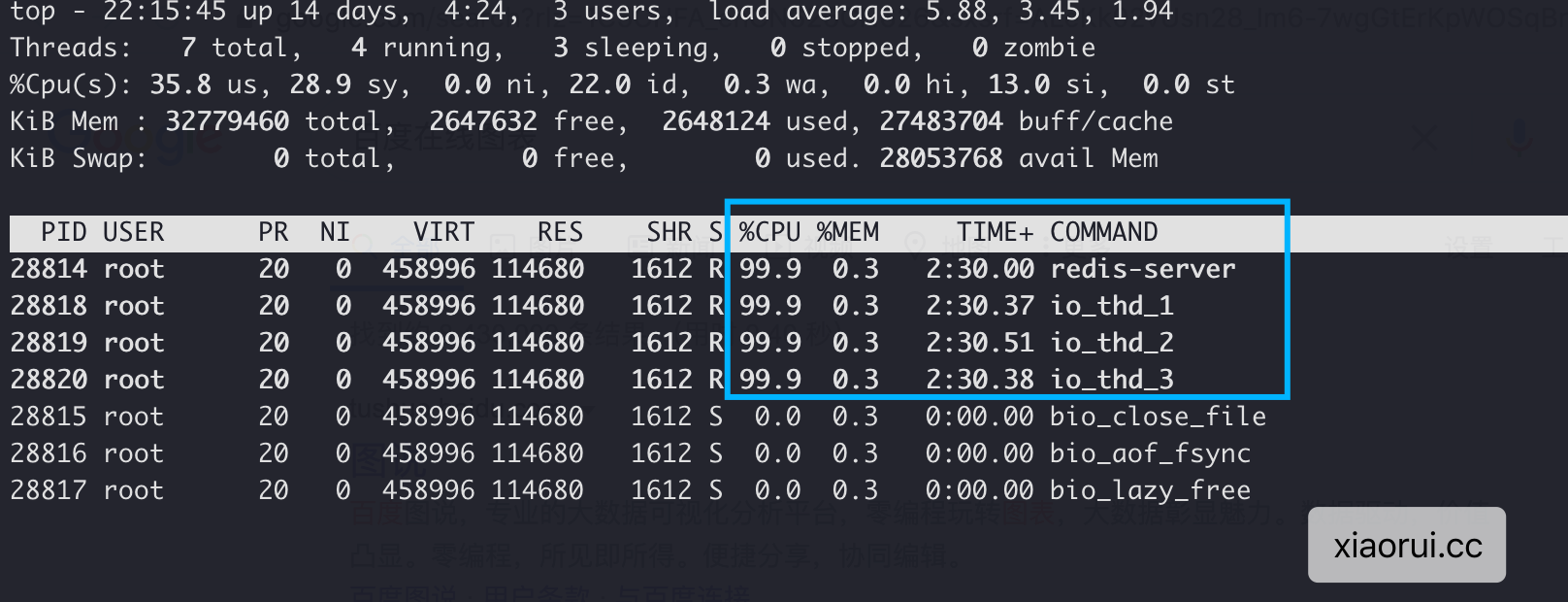
开启8个io thread线程的效果。8个线程把8个cpu core负载跑的差不多了,但qps却不升反降。
// xiaorui.cc
benchmark 6379 clients 16
126968.01 requests per second
129015.61 requests per second
benchmark 6379 clients 32
121197.42 requests per second
126968.01 requests per second
benchmark 6379 clients 64
109583.04 requests per second
131138.94 requests per second
benchmark 6379 clients 128
140331.19 requests per second
142846.94 requests per second
benchmark 6379 clients 256
145422.81 requests per second
156862.75 requests per second
benchmark 6379 clients 512
150886.45 requests per second
159936.03 requests per second
benchmark 6379 clients 1024
150840.94 requests per second
163198.69 requests per second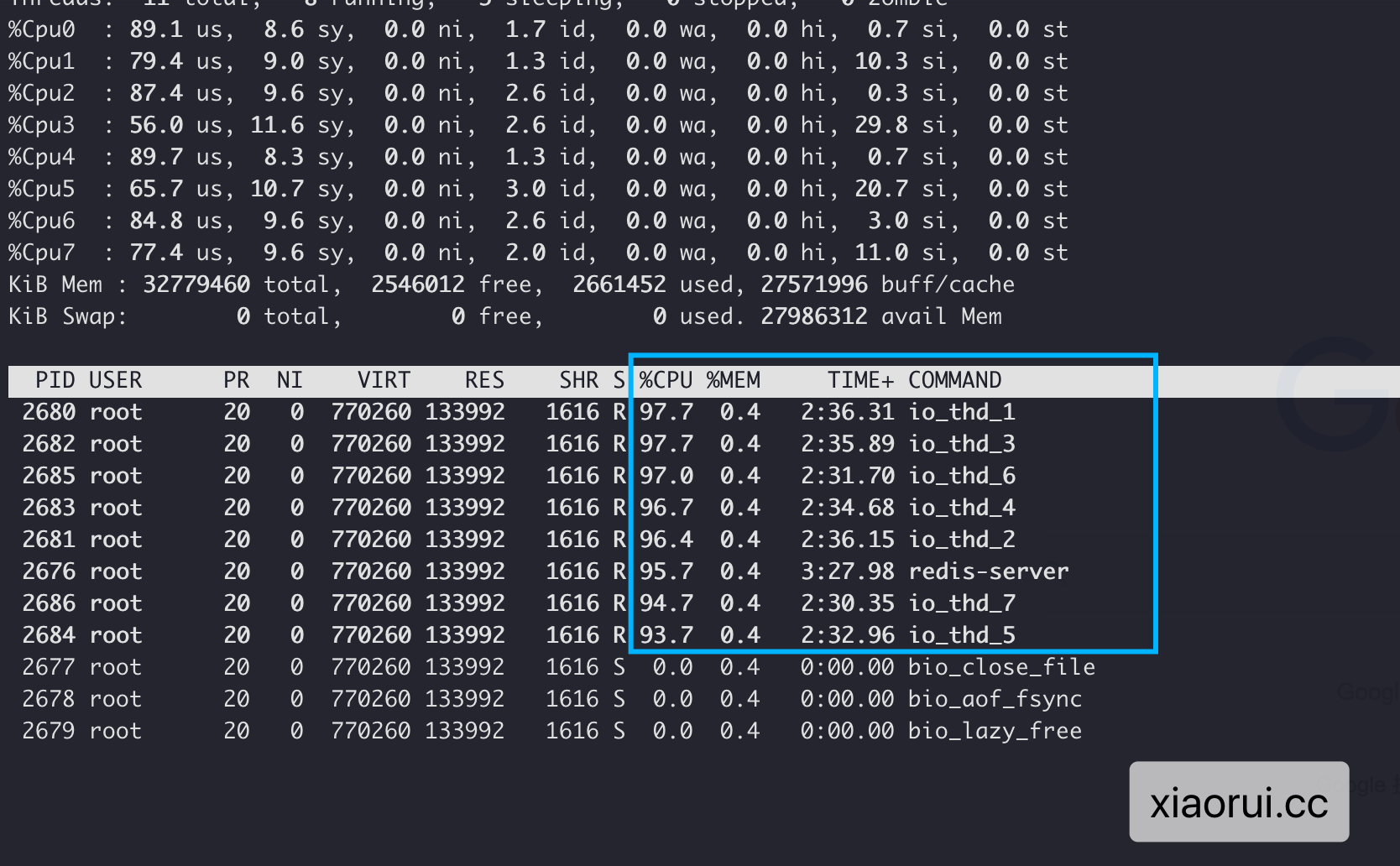
redis6的性能瓶颈?
通过perf采集redis6在benchmark压测时的数据,分析瓶颈点在于忙轮询。性能瓶颈跟redis6的多线程本身设计有大关系的,当每次调用aeApiPoll获取的事件超过io线程数的两倍时,就会触发io线程的调度。io线程在完成任务后会尝试轮询任务,直到有新任务或100w次的轮询后进入pthread_mutex_lock休眠。
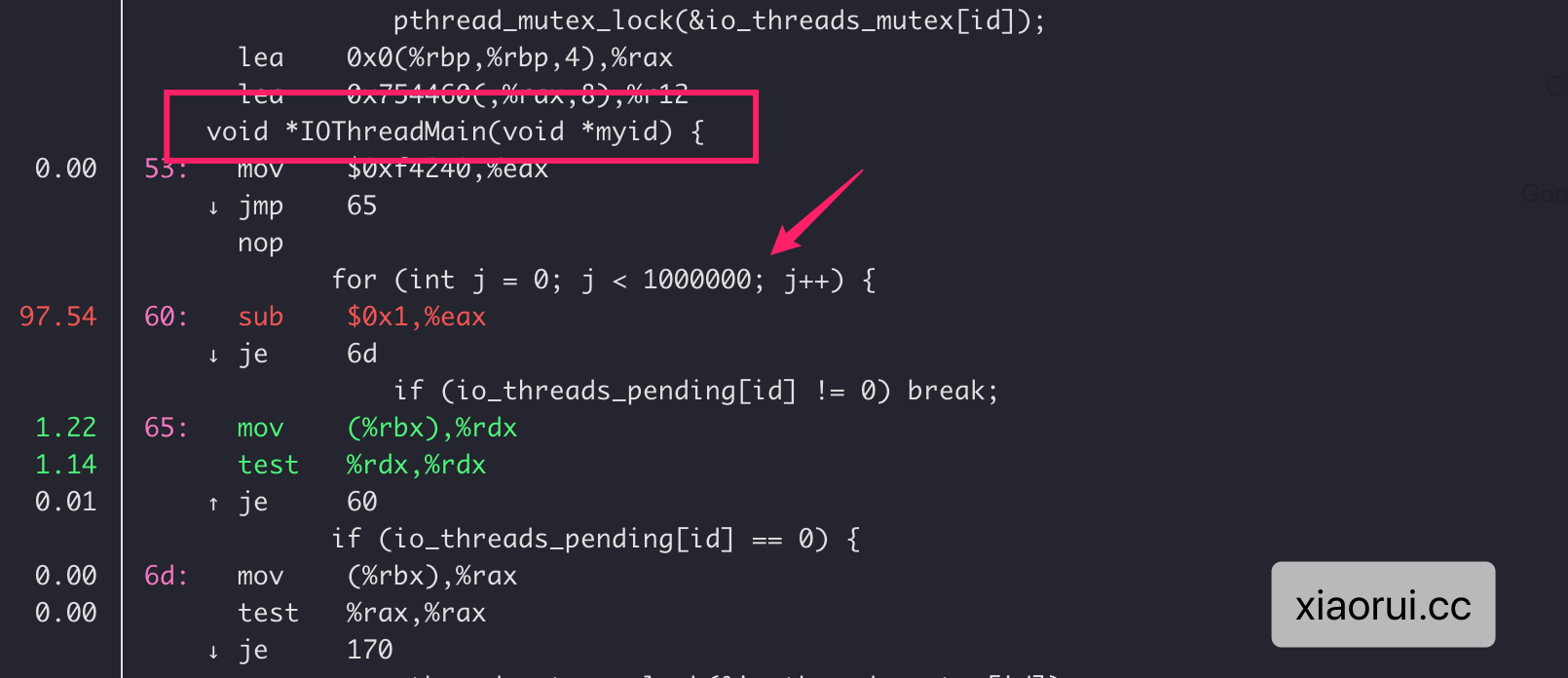
redis conf注释里为什么推荐io thread为4个?通过上面的8个线程已经测试得出,在超过4个io线程后性能不升反降的。原因?还是轮询。
⚠️ 在cpu 64 core的服务器已测试8、16、32 io thread线程,benchmark数据会随着线程数增长越来越不理想,体现在cpu的开销和qps反差大。⚠️
cpu不同benchmark压测结果自然也不同,我分别使用云厂商常用的intel铂金和黄金cpu测试,压测结果有明显差异,这个跟cpu主频和多级缓存的大小有关系。使用Platinum 8269CY 2.5mhz做测试,他的io thread多线程提升在50%-60%左右。但由于Platinum cpu多级缓存大,减少了cache miss,所以QPS本就比前面gold系列表现的好。
压力测试 ” Intel Platinum 8269CY CPU @ 2.50GHz ” 的表现,下面是不开启io线程。
// xiaorui.cc
benchmark 6379 clients 16
156838.14 requests per second
163251.97 requests per second
benchmark 6379 clients 64
166638.89 requests per second
170212.77 requests per second
benchmark 6379 clients 128
163265.31 requests per second
170212.77 requests per second
benchmark 6379 clients 256
166652.77 requests per second
166666.67 requests per second
benchmark 6379 clients 512
163185.39 requests per second
163251.97 requests per second
benchmark 6379 clients 1024
166611.14 requests per second
159961.61 requests per second开启4个io线程的压测表现。
// xiaorui.cc
benchmark 6379 clients 16
199980.00 requests per second
205107.16 requests per second
benchmark 6379 clients 64
266560.06 requests per second
266666.66 requests per second
benchmark 6379 clients 128
257964.67 requests per second
281491.91 requests per second
benchmark 6379 clients 256
249937.52 requests per second
266560.06 requests per second
benchmark 6379 clients 512
250156.34 requests per second
266631.12 requests per second
benchmark 6379 clients 1024
263088.66 requests per second
285551.09 requests per second如简单QPS来分析,开不开io多线程都要比 ” Intel Gold 6151 CPU @ 3.00GHz” 高一些 。在redis的场景来说,cpu多级缓存大小很重要。由于云平台屏蔽了相关检测,使用perf无法探测到cache miss。
// xiaorui.cc
perf stat -a -e cache-misses,cache-references -- sleep 10
Performance counter stats for 'system wide':
<not supported> cache-misses
<not supported> cache-references
10.000744488 seconds time elapsed不太推荐使用redis6多线程?
就拿官方推荐的4个io thread线程来说,4个io线程加主线程都cpu 100% 的情况下才可超过接近一倍的qps,那还真不如使用redis cluster集群方案 😅。当然redis cluster是有运维成本,对于一些组合的多指令需要智能客户端或代理层解决。
在社区中跟阿里云redis团队聊过,他们的redis多线程为流水线模型,减少了过多的轮询开销。设计上有些像memcached,类似multi reactor的网络模型设计,主线程去监听新连接,通过pipe来通知其他线程新连接,其他线程各自构建event loop。😅
下面是在社区里找到的关于阿里云redis流水线模型设计,单看设计模型确实要比redis6显得优雅些,也更好理解。但由于阿里云redis非开源版,所以性能消耗如何不得而知了。
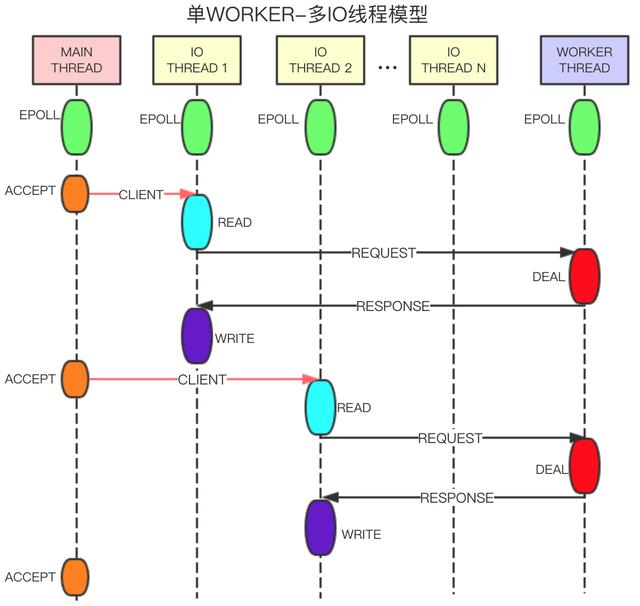
主线程接受连接,创建client,将连接转发给IO线程。IO线程处理连接的读写事件,解析命令,将解析的完整命令转发给WORKER线程处理,发送response包,负责删除连接等。WORKER线程负责命令的处理,生成客户端回包,定时器事件的执行等。
主线程,IO线程,WORKER线程都有单独的事件驱动,线程之间通过无锁队列交换数据,通过管道进行消息通知。这样的设计可以让不同工种的线程都可以并行跑起来,而redis6同一时间只能跑一块逻辑,要么正监听获取ae事件, 要么几个io thread在解封包,要么在执行数据处理逻辑,而阿里云的redis看设计是可以同时工作起来。
据阿里云redis团队说,在常规使用的需求下,他们的提升最少有三倍左右。近几年阿里云对redis的代码贡献已经排在第三了,仅次于作者和redislabs。阿里云真是没少折腾呀。😁
总结
redis6的io多线程到底实不实用? 看你的需求了,个人建议上redis集群来扩展高并发的需求。


